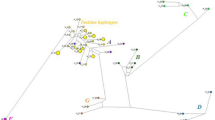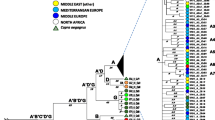Abstract
Indigenous Chinese goat mtDNA is highly diverse but lacks geographic specificity; however, whether gene flow or gene exchange contributed to this remains unknown. We reanalyzed a consensus fragment of 481 bp in the D-loop region from 339 individuals. The network and neighbor-joining tree revealed three divergent maternal haplogroups (A, B1, and B2) in 17 local breeds. Although high polymorphism resulting in 198 different haplotypes was observed (h = 0.984 ± 0.002; π = 0.0336 ± 0.0008), neither the distribution of haplotypes nor PCA analysis revealed any obvious geographic structure in the local breeds. Extensive gene flow was widely detected among breeds from southwest China. High levels of gene exchange were detected between Qianbei Brown goats and the other breeds, indicating either more contribution or introgression to their gene pools. This study will be helpful in understanding the phylogeography and gene flow among the goat breeds of southwest China.





Similar content being viewed by others
References
Chen SY, Su YH, Wu SF, Sha T, Zhang YP (2005) Mitochondrial diversity and phylogeographic structure of Chinese domestic goats. Mol Phylogenet Evol 37:804–814
China National Commission of Animal Genetic Resources (2011) Animal genetic resources in China sheep and goat. China Agriculture Press, Beijing
Fernandez H, Hughes S, Vigne JD, Helmer D, Hodgins G, Miquel C, Hanni C, Luikart G, Taberlet P (2006) Divergent mtDNA lineages of goats in an Early Neolithic site, far from the initial domestication areas. Proc Natl Acad Sci USA 103:15375–15379
Li MH, Zhao SH, Bian C, Wang HS, Wei H, Liu B, Yu M, Fan B, Chen SL, Zhu MJ, Li SJ, Xiong TA, Li K (2002) Genetic relationships among twelve Chinese indigenous goat populations based on microsatellite analysis. Genet Sel Evol 34:729–744
Liu RY, Yang GS, Lei CZ (2006) The genetic diversity of mtDNA D-loop and the origin of Chinese goats. Acta Genet Sin 33:420–428
Liu YP, Cao SX, Chen SY, Yao YG, Liu TZ (2009) Genetic diversity of Chinese domestic goat based on the mitochondrial DNA sequence variation. J Anim Breed Genet 126:80–89
Luikart G, Gielly L, Excoffier L, Vigne JD, Bouvet J, Taberlet P (2001) Multiple maternal origins and weak phylogeographic structure in domestic goats. Proc Natl Acad Sci USA 98:5927–5932
Naderi S, Rezaei HR, Taberlet P, Zundel S, Rafat SA, Naghash HR, Elbarody M, Ertugrul O, Pompanon F (2007) Large-scale mitochondrial DNA analysis of the domestic goat reveals six haplogroups with high diversity. PLoS ONE 2:10
Pietro P, Maria F, Gian Franco G, Giuseppe E (2003) The complete nucleotide sequence of goat (Capra hircus) mitochondrial genome. Mitochondrial DNA 14:199–203
Qi Y, Luo J, Han XF, Zhu YZ, Chen C, Liu JX, Sheng HJ (2009) Genetic diversity and relationships of 10 Chinese goat breeds in the Middle and Western China. Small Ruminant Res 82:88–93
Sambrook J, Russell DW (2001) Molecular cloning, 3rd edn. Cold Spring Harbor Laboratory Press, New York
Sultana S, Mannen H, Tsuji S (2003) Mitochondrial DNA diversity of Pakistani goats. Anim Genet 34:417–421
Tamura K, Dudley J, Nei M, Kumar S (2007) Mega4: molecular evolutionary genetics analysis (MEGA) software version 4.0. Mol Biol Evol 24:1596–1599
Wright S (1931) Evolution in Mendelian population. Genetics 16:91–159
Wu YP, Huo JH, Xie JF, Guan WJ, Zhao QJ, He XH, Pu YB, Ma YH (2009a) Genetic relationships of goat breeds using microsatellite and mitochondrial DNA markers. Chin Agric Sci Bull 25:7–12
Wu YP, Guan WJ, Zhao QJ, He XH, Pu YB, Huo H, Xie JF, Han JL, Rao SQ, Ma YH (2009b) A fine map for maternal lineage analysis by mitochondrial hypervariable region in 12 Chinese goat breeds. J Anim Sci 80:372–380
Zeder M, Hesse B (2000) The initial domestication of goat (Capra hircus) in the Zagros Mountains 10,000 years ago. Science 287:2254–2257
Zhao YZ (1995) Goat production. Chinese Agricultural Press, Beijing, pp 24–26 (in Chinese)
Zhao YJ, Zhang JH, Zhao EH, Zhang XG, Liu XY, Zhang NY (2011) Mitochondrial DNA diversity and origins of domestic goats in Southwest China (excluding Tibet). Small Rumin Res 95:40–47
Acknowledgments
This work was supported by grants from the National Spark Key Program (2012GA810001) and Sichuan Province Science and Technology Support Program (2011NZ0003, 2011NZ0099-36)
Author information
Authors and Affiliations
Corresponding author
Rights and permissions
About this article
Cite this article
Zhao, W., Zhong, T., Wang, L.J. et al. Extensive Female-Mediated Gene Flow and Low Phylogeography Among Seventeen Goat Breeds in Southwest China. Biochem Genet 52, 355–364 (2014). https://doi.org/10.1007/s10528-014-9652-y
Received:
Accepted:
Published:
Issue Date:
DOI: https://doi.org/10.1007/s10528-014-9652-y




